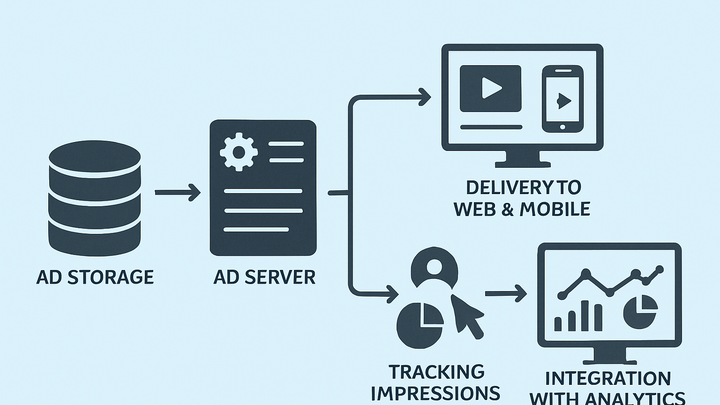Published on 2025-06-22T06:25:24Z
What is an Ad Server? Definition and Examples
An ad server is a technology platform that stores, manages, and delivers digital advertisements to websites, mobile apps, and other digital channels. It acts as the central hub for ad trafficking, controlling when and where ads appear, tracking impressions, clicks, and other performance metrics. Ad servers enable marketers and publishers to set up campaigns, target specific audiences, and optimize delivery based on real-time data. They also provide reporting dashboards for monitoring campaign performance and making data-driven decisions. By combining ad-serving capabilities with robust analytics, ad servers help maximize ROI and efficiency in digital advertising.
Ad server
A platform that stores, delivers, and tracks digital ads, enabling marketers to manage campaigns and measure performance.
Overview of Ad Servers
This section provides a high-level look at what ad servers are and why they are essential in digital advertising.
-
What is an ad server?
An ad server is a software solution that stores ad creatives, decides which ad to deliver to a specific user at a specific time, and tracks ad delivery metrics such as impressions and clicks.
Types of Ad Servers
Ad servers can be categorized based on ownership and functionality, affecting how campaigns are managed and reported.
-
First-party (owned) ad server
Managed directly by a publisher or advertiser on their own domain, providing full control over data and creative delivery.
-
Pros
Complete data ownership, deeper integration with internal systems.
-
Cons
Requires technical expertise, higher setup and maintenance costs.
-
-
Third-party ad server
Hosted by an external vendor, enabling centralized campaign management across multiple publishers and advertisers.
-
Pros
Quick deployment, access to cross-network targeting.
-
Cons
Potential data privacy concerns, limited direct control over the infrastructure.
-
Key Features of Ad Servers
Effective ad servers offer a suite of features that support ad trafficking, audience targeting, and performance reporting.
-
Ad trafficking and delivery
Schedules and serves the right creative to the right user at the right time, ensuring frequency caps and pacing rules are respected.
-
Targeting and segmentation
Allows selection of audiences based on demographics, interests, geolocation, and custom data segments.
-
Reporting and analytics
Generates real-time metrics on impressions, clicks, viewability, and conversions, often with customizable dashboards.
-
Optimization and yield management
Automates bid adjustments, creative rotation, and allocation rules to maximize revenue and campaign performance.
Integrating Ad Servers with Analytics Platforms
Ad performance data is often combined with broader user analytics to understand the full customer journey.
-
GA4 integration
Leverage Google Analytics 4 to import ad impression and click data from your ad server for unified reporting. Use the Measurement Protocol to send custom ad events or set up Data Import to combine offline ad logs with GA4 events.
-
Measurement protocol
Send HTTP requests with ad event data directly to GA4 for granular tracking.
-
Data import
Upload ad server logs into GA4 to merge with web and app analytics for end-to-end attribution.
-
-
PlainSignal integration
Use PlainSignal’s cookie-free analytics to track ad-driven visits and engagement without relying on third-party cookies. Embed the PlainSignal snippet on landing pages like this:
<link rel="preconnect" href="//eu.plainsignal.com/" crossorigin /> <script defer data-do="yourwebsitedomain.com" data-id="0GQV1xmtzQQ" data-api="//eu.plainsignal.com" src="//cdn.plainsignal.com/plainsignal-min.js"></script>
Popular Use Cases and Benefits
Ad servers support a range of advertising strategies and deliver measurable value to marketers and publishers.
-
Direct campaign management
Advertisers host creatives on a first-party ad server to maintain control over delivery and reporting.
-
Programmatic and rtb
Third-party ad servers integrate with Demand-Side Platforms (DSPs) and Supply-Side Platforms (SSPs) for automated buying and selling of ad inventory in real time.
-
Cross-channel attribution
Integrate ad server data with web, mobile, and offline analytics to understand multi-touch attribution and ROI.
